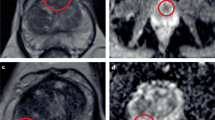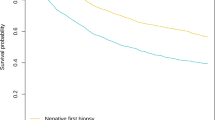Key Points
-
A number of guidelines have been published that include criteria for active surveillance (AS) enrolment and subsequent management to assist clinicians and patients in critically important treatment related decision-making
-
Consensus on inclusion criteria, surveillance schedules and intervention thresholds is currently lacking
-
The future of AS and its uptake as a management modality will depend on better patient selection and validated monitoring schedules to improve identification of disease progression
-
Combining existing evidence and gathering more long-term evidence is needed to derive a broadly supported guideline to reduce variations in clinical practice and to optimize clinical decision-making
Abstract
In the past decade active surveillance (AS) of men with localized prostate cancer has become an increasingly popular management option, and a range of clinical guidelines have been published on this topic. Existing guidelines regarding AS for prostate cancer vary widely, but predominantly state that the most suitable patients for AS are those with pretreatment clinical stage T1c or T2 tumours, serum PSA levels <10 ng/ml, biopsy Gleason scores of 6 or less, a maximum of one or two tumour-positive biopsy core samples and/or a maximum of 50% of cancer per core sample. Following initiation of an AS programme, most guidelines recommend serial serum PSA measurements, digital rectal examinations and surveillance biopsies to check for and identify pathological indications of tumour progression. Definitions of disease reclassification and progression differ among guidelines and multiple criteria for initiation of definitive treatment are proposed. The variety of descriptions of criteria for clinically insignificant prostate cancer indicates a lack of consensus on optimal AS and intervention thresholds. A single set of guidelines are needed in order to reduce variations in clinical practice and to optimize clinical decision-making. To enable truly evidence-based guidelines, further research that combines existing evidence, while also gathering information from more long-term studies is needed.
This is a preview of subscription content, access via your institution
Access options
Subscribe to this journal
Receive 12 print issues and online access
$209.00 per year
only $17.42 per issue
Buy this article
- Purchase on Springer Link
- Instant access to full article PDF
Prices may be subject to local taxes which are calculated during checkout
Similar content being viewed by others
References
Center, M. M. et al. International variation in prostate cancer incidence and mortality rates. Eur. Urol. 61, 1079–1092 (2012).
Kim, T. H. et al. Pathological upgrading and upstaging of patients eligible for active surveillance according to currently used protocols. Int. J. Urol. 21, 377–381 (2013).
Schroder, F. H. et al. Screening and prostate cancer mortality: results of the European Randomised Study of Screening for Prostate Cancer (ERSPC) at 13 years of follow-up. Lancet 384, 2027–2035 (2014).
Duffy, M. J. PSA in screening for prostate cancer: more good than harm or more harm than good? Adv. Clin. Chem. 66, 1–23 (2014).
Stenman, U. H. et al. Prognostic value of serum markers for prostate cancer. Scand. J. Urol. Nephrol. Suppl. 216, 64–81 (2005).
Hugosson, J. & Carlsson, S. Overdetection in screening for prostate cancer. Curr. Opin. Urol. 24, 256–263 (2014).
Bul, M. et al. Active surveillance for low-risk prostate cancer worldwide: the PRIAS study. Eur. Urol. 63, 597–603 (2013).
Klotz, L. Active surveillance for prostate cancer: patient selection and management. Curr. Oncol. 17, S11–S17 (2010).
Ip, S. et al. An evidence review of active surveillance in men with localized prostate cancer. Evid. Rep. Technol. Assess. (Full Rep.) 204, 1–341 (2011).
Cancer Care Nova Scotia (CCNS). Guidelines for the management of prostate cancer. [online], (2006).
The National Comprehensive Cancer Network (NCCN). NCCN clinical practice guidelines in oncology. Prostate cancer. [online], (2014).
The National Institute for Health and Clinical Excellence (NICE). Prostate cancer: diagnosis and management. [online], (2014).
American Urological Association (AUA). Guideline for the management of clinically localized prostate cancer: 2007 update. [online], (2007).
European Association of Urology (EAU). Guidelines on prostate cancer. [online], (2014).
German Society of Urology (GSU). Interdisziplinäre Leitlinie der Qualität S3 zur Früherkennung, Diagnose und Therapie der verschiedenen Stadien des Prostatakarzinoms. Urologenportal [online], (2014).
Dutch Urological Association (DUA). Richtlijn prostaatcarcinoom. Richtlijnendatabase [online], (in Dutch) (2014).
Belgian Healthcare Knowledge Centre (KCE). A national clinical practice guideline on the management of localised prostate cancer. [online], (2013).
South East Scotland Cancer Network (SCAN). SCAN guideline for active surveillance (deferred radical treatment) of early, low-risk, prostate cancer. [online], (2015).
Aragon Institute of Health Sciences (I+CS). Clinical practice guideline for prostate cancer treatment. Biblioteca de Guias del Practica Clinica del Systema Nacional de Salud [online], (2008).
Alberta Health Services (AHS). Alberta Health Services clinical practice guideline: prostate cancer. [online], (2014).
Singapore Ministry of Health (NCCS). Guidelines on Management of Prostate Cancer. Annals Academy of Medicine, Singapore [online], (2013).
Prostate Cancer Taskforce (PCT). Diagnosis and management of prostate cancer in New Zealand men: recommendations from the Prostate Cancer Taskforce. The New Zealand Ministry of Health [online], (2013).
The Finnish Medical Society Duodecim (FCCG). Prostate cancer (Eturauhassyöpä). SCAN [online], (in Finnish) (2014).
Cancer Care Ontario (CCO) Evidence Based Guideline Quality Initiative. Active surveillance for the management of localized prostate cancer: guideline recommendations. Can. Urol. Assoc. J. 9, 171–178 (2015).
Prostate Cancer Foundation of Australia and Cancer Council Australia PSA Testing Guidelines Expert Advisory Panel. Draft clinical practice guidelines PSA Testing and Early Management of Test-Detected Prostate Cancer. Cancer Council Australia [online], (2015).
AGREE Next Steps Consortium. The AGREE II Instrument [Electronic version] 2009. The Agree Enterpise [online], (2013).
Joosen, M. C. et al. An international comparison of occupational health guidelines for the management of mental disorders and stress-related psychological symptoms. Occup. Environ. Med. 72, 313–322 (2015).
Memorial Sloan Kettering Cancer Center. Prediction tools: prostate cancer. [online], (2015).
Dall'era, M. A. et al. Active surveillance for early-stage prostate cancer: review of the current literature. Cancer 112, 1650–1659 (2008).
Welty, C. J. et al. Extended followup and risk factors for disease reclassification in a large active surveillance cohort for localized prostate cancer. J. Urol. 193, 807–811 (2015).
Tosoian, J. J. et al. Intermediate and longer-term outcomes from a prospective active-surveillance program for favorable-risk prostate cancer. J. Clin. Oncol. 33, 3379–3385 (2015).
Klotz, L. et al. Long-term follow-up of a large active surveillance cohort of patients with prostate cancer. J. Clin. Oncol. 33, 272–277 (2015).
Lund, L., Svolgaard, N. & Poulsen, M. H. Prostate cancer: a review of active surveillance. Res. Rep. Urol. 6, 107–112 (2014).
Azmi, A. et al. Active surveillance for low-risk prostate cancer: diversity of practice across Europe. Ir. J. Med. Sci. 184, 305–311 (2014).
Kweldam, C. F., Wildhagen, M. F., Bangma, C. H. & van Leenders, G. J. Disease-specific death and metastasis do not occur in patients with Gleason score ≤6 at radical prostatectomy. BJU Int. 116, 230–235 (2015).
Payer, L. P. Medicine Culture: Varieties of treatment in the United States, England, West Germany, and France (Henry Holt and Company, 1989).
Welch, H. G. & Albertsen, P. C. Prostate cancer diagnosis and treatment after the introduction of prostate-specific antigen screening: 1986–2005. J. Natl Cancer Inst. 101, 1325–1329 (2009).
Xu, J., Neale, A. V., Dailey, R. K., Eggly, S. & Schwartz, K. L. Patient perspective on watchful waiting/active surveillance for localized prostate cancer. J. Am. Board Fam. Med. 25, 763–770 (2012).
McVey, G. P. et al. Initial management of low-risk localized prostate cancer in the UK: analysis of the British Association of Urological Surgeons Cancer Registry. BJU Int. 106, 1161–1164 (2010).
Cooperberg, M. R., Broering, J. M. & Carroll, P. R. Time trends and local variation in primary treatment of localized prostate cancer. J. Clin. Oncol. 28, 1117–1123 (2010).
van den Bergh, R. C. et al. Novel tools to improve patient selection and monitoring on active surveillance for low-risk prostate cancer: a systematic review. Eur. Urol. 65, 1023–1031 (2014).
Loeb, S. et al. Active surveillance for prostate cancer: a systematic review of clinicopathologic variables and biomarkers for risk stratification. Eur. Urol. 67, 619–626 (2015).
Klein, E. A. et al. A 17-gene assay to predict prostate cancer aggressiveness in the context of Gleason grade heterogeneity, tumor multifocality, and biopsy undersampling. Eur. Urol. 66, 550–560 (2014).
Sartori, D. A. & Chan, D. W. Biomarkers in prostate cancer: what's new? Curr. Opin. Oncol. 26, 259–264 (2014).
Parekh, D. J. et al. A multi-institutional prospective trial in the USA confirms that the 4Kscore accurately identifies men with high-grade prostate cancer. Eur. Urol. 68, 464–470 (2015).
Schoots, I. G. et al. Magnetic resonance imaging in active surveillance of prostate cancer: a systematic review. Eur. Urol. 67, 627–636 (2015).
Sankineni, S., Osman, M. & Choyke, P. L. Functional MRI in prostate cancer detection. Biomed. Res. Int. 2014, 590638 (2014).
Symons, J. L. et al. Outcomes of transperineal template-guided prostate biopsy in 409 patients. BJU Int. 112, 585–593 (2013).
Bellardita, L. et al. How does active surveillance for prostate cancer affect quality of life? a systematic review. Eur. Urol. 67, 637–645 (2014).
McIntosh, H. M. et al. Follow-up care for men with prostate cancer and the role of primary care: a systematic review of international guidelines. Br. J. Cancer 100, 1852–1860 (2009).
Dahm, P., Yeung, L. L., Chang, S. S. & Cookson, M. S. A critical review of clinical practice guidelines for the management of clinically localized prostate cancer. J. Urol. 180, 451–459 (2008).
Wollersheim, H., Burgers, J. & Grol, R. Clinical guidelines to improve patient care. Neth. J. Med. 63, 188–192 (2005).
Jones, J. & Hunter, D. Consensus methods for medical and health services research. BMJ 311, 376–380 (1995).
Acknowledgements
This study is linked to a larger project, the Movember Foundation's Global Action Plan on active surveillance for low-risk prostate cancer (GAP3), which is collaboration between institutions, hospitals and research centres in Australia, Canada, France, Finland, Italy, Japan, Netherlands, UK and the USA. The Movember Foundation has invested €1,664,950 in the GAP3 project in order to create the largest centralized database on AS in men with prostate cancer to date, comprising around 40% of all global patient data on AS. The funder did not play any role in the study design, collection, analysis or interpretation of data, or in the drafting of this paper.
Author information
Authors and Affiliations
Consortia
Contributions
S.M.B., M.S.L., N.P., M.W. and L.P.B. researched data for the article. All authors provided a substantial contribution to discussions of content. S.M.B., M.S.L., N.P., M.W. and L.P.B. wrote the manuscript and all authors, and other members of the Movember GAP3 consortium reviewed and/or edited the manuscript before submission.
Corresponding author
Ethics declarations
Competing interests
The authors declare no competing financial interests.
Rights and permissions
About this article
Cite this article
Bruinsma, S., Bangma, C., Carroll, P. et al. Active surveillance for prostate cancer: a narrative review of clinical guidelines. Nat Rev Urol 13, 151–167 (2016). https://doi.org/10.1038/nrurol.2015.313
Published:
Issue Date:
DOI: https://doi.org/10.1038/nrurol.2015.313
This article is cited by
-
Risk of progression following a negative biopsy in prostate cancer active surveillance
Prostate Cancer and Prostatic Diseases (2023)
-
The impact of AirSeal® on complications and pain management during robotic-assisted radical prostatectomy: a single-tertiary center study
World Journal of Urology (2023)
-
Active-Surveillance-Kriterien auf dem Prüfstand
Uro-News (2023)
-
Promoting the use of the PRECISE score for prostate MRI during active surveillance: results from the ESOR Nicholas Gourtsoyiannis teaching fellowship
Insights into Imaging (2022)
-
Active surveillance inclusion criteria under scrutiny in magnetic resonance imaging-guided prostate biopsy: a multicenter cohort study
Prostate Cancer and Prostatic Diseases (2022)



